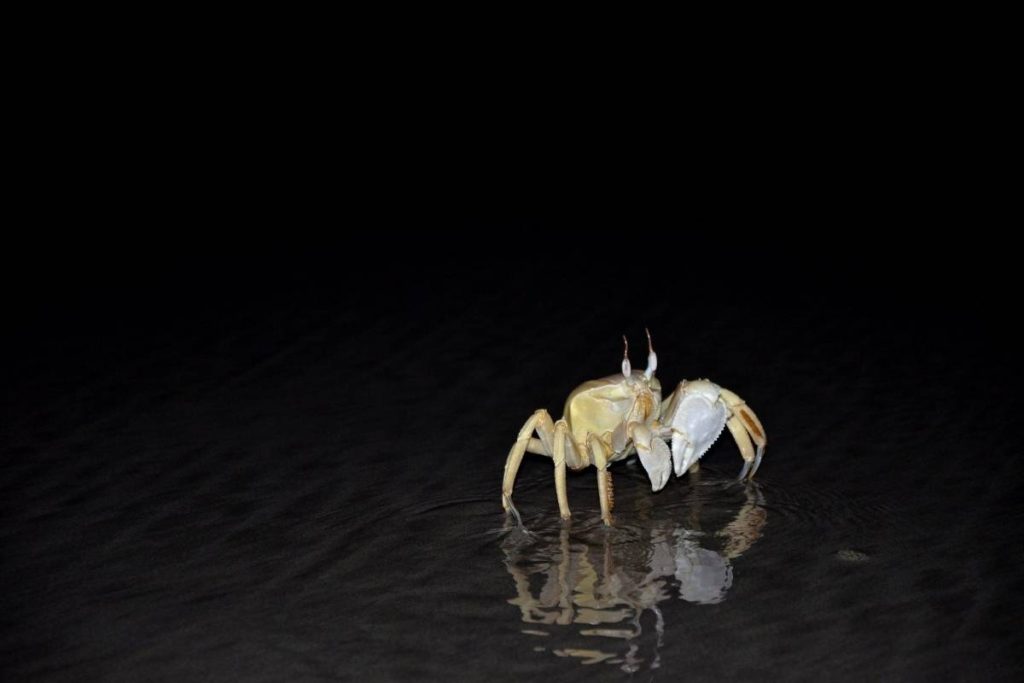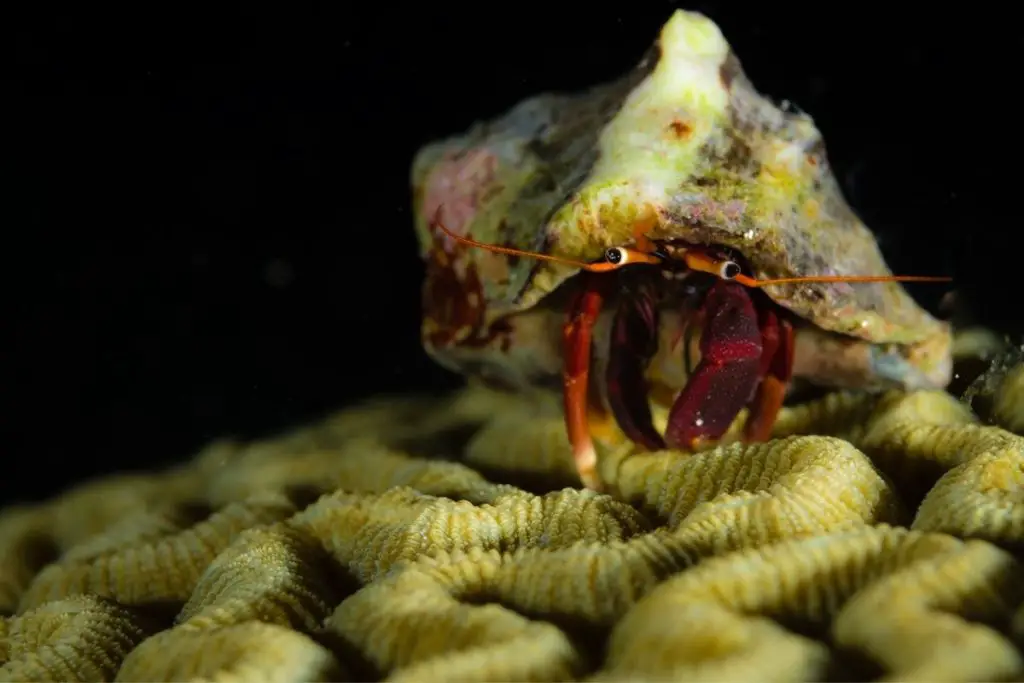Crabs belong to the subphylum of crustaceans which is a group of animals that have a shell (exoskeleton) rather than bones. They include shellfish such as shrimp, lobsters, crayfish, krill, and crabs.
Crabs live in every ocean in the world, in freshwater, and on land. The vast majority of crabs are nocturnal, but there are some diurnal crab species and some species that adapt to be nocturnal or diurnal depending on certain conditions.
Recent studies suggest that the crustaceans (the clade to which crabs belong) do in fact sleep. Their brains emit slow waves of electricity similar to that found in sleeping mammals.
The study indicated that during sleep, the crustaceans were less responsive to outside stimuli and were less alert.
While scientists have been able to observe and document that many crab species do indeed sleep, we cannot fully describe the sleeping habits of all crabs, as there are massive variations between species and their habitats, and not all species have been studied extensively.
Some may sleep at night while others sleep during the daytime, and some have no real circadian rhythm.
Changes in environment, and temperature can change its sleeping habits and cycle. This includes where, how, and how long they sleep. Nocturnal crabs will sleep or remain very inactive during the day, hiding in dark, moist rocky crevices or burrowing in sand.
Deep sea crab species, like the large-clawed spider crab, live in environments with no light and fewer predators, making adherence to a set day/night rhythm hard.
The conditions in which a crab species live, strongly influence its sleeping habits and other hibats such as their diet.
Despite my search in the scientific literature, the sleeping habits or even whether they sleep at all, in these deep-sea conditions aren’t well described.
Since there is no light at these depths, it is likely that something other than the sun determines their sleeping cycles. Such as nutrient availability or the strength of undercurrents.
Are Crabs Nocturnal or Diurnal?
Whether crabs sleep at night or during the day depends on whether they are nocturnal or diurnal. Almost all crabs are nocturnal, meaning they are awake and active at night.
But several species of crabs can be diurnal, meaning they are active and awake during the day. Crabs’ nocturnal behavior is an adaptation to avoid predators, higher temperatures, and dehydration.
A nocturnal crab, like the Emerald crab (Mithraculus sculptus), sleeps during the day and is active during the night.
Whereas a fiddler crab, which can be diurnal depending on the tide, would sleep at night, and is active during the day where it forages for food on land.
One species, the fiddler crab (Uca Spp.), lives in intertidal zones, which has resulted in a unique adaptation.

The fiddler crab has adapted to align their active hours to the tidal cycle and the day-night cycle.
What this means, is that the fiddler crab is more active at low tide, regardless of what time of day this is, to be able to search for food, and is less active and sleeps during low tide.
However, the fiddler crab will still wait for low tide and daytime to coincide to do activities, like mating displays, for better visibility.
Therefore, the fiddler crab is considered both diurnal and nocturnal, and modifies this behaviour to align with the tides.
How do crabs sleep?
How crabs sleep also depends on the specific crab, and whether enough research has been done to accurately describe it. For example, we know quite a lot about the sleeping habits and patterns of hermit crabs because they are a common pet.
A common sleeping position for hermit crabs is to hold the shell over their eyes, with their legs partially sticking out of their shell. Hermit crabs have also been observed sleeping on their backs.
There is limited data to determine how much crabs sleep in nature. We do know that a crab’s sleep can be interrupted, causing them to leave their burrows due to predators, sudden changes in environment, or being washed away by tides or strong waves or currents from storms.
Hermit crabs, a common pet, are nocturnal and have been observed to sleep around 8 hours during the day.

Where do crabs sleep?
Where crabs sleep is dependent on the species of crab and whether they are land or aquatic crabs.
Land or terrestrial crabs, like the coconut crab or land hermit crabs, can breathe without water. They have gills, which need to be kept moist, however full submersion in water would kill them. Whereas aquatic crabs breathe by passing water over the gills, which extracts the oxygen.
Aquatic crabs have adaptations that mean they can live 1-2 days out of the water, but eventually must return to the water.
Land crabs like the coconut crab are typically nocturnal to avoid the danger of higher temperatures during the day.
During the day, land crabs will dig burrows in moist dirt or sand for protection from the sun and predators, and sleep.
Other crabs will find shelter in dark, moist crevices or caves near tidepools or along the rocky shoreline.
Blue crabs (Callinectes sapidus) are nocturnal marine crabs known for being active swimmers. They likely sleep during the day, where they bury themselves in the sediment for protection against preditors.
Sand crabs (the common name for genus Emerita) are nocturnal land crabs, living in beaches and dunes. During the day, they burrow in the sand in the wave breaking zone.
King crabs, of the Lithodoidea superfamily, are nocturnal, but we don’t know much else. King crabs typically live in very deep waters, so they are difficult to research. We do know that red king crabs (Paralithodes camtschaticus) form pods (called podding) at night for foraging and protection.
Emerald crabs (Mithraculus sculptus) are nocturnal and sleep in dark caves, crevices and under rocks.
Not a lot of research has been done to investigate whether crabs always sleep underwater or sometimes also on land – or in the vicinity of water e.g., in the mud or wet sand.

But based on the literature I was able to find, it seems likely that most aquatic crabs mainly sleep underwater in a protected habitat, such as cave or rock crevice, or burrow itself in the sand and sediment under water.
It does make sense that most crabs sleep under water, as described earlier, aquatic crabs need their gills to always be submerged or moist to breathe.
While aquatic crabs go onto land in the search of food for 1 to 2 days, they prefer to sleep in their more native habitats – covered in water!
Conclusion
In conclusion, all crabs sleep. But where and when this occurs is very dependent on the species of crab.
The majority of crabs are nocturnal, and therefore sleep during the day. In general, land crabs sleep on land and marine crabs will sleep underwater.
They sleep for the same reason as you and I do – to save energy and to regenerate!
If you are interested in the sleeping habits of animals, maybe you will like my recent post on how seahorses sleep (its fascinating!) and maybe you want to know if tadpoles sleep at all?
References
Barnwell, F.H. (1968). The role of rhythmic systems in the adaptation of fiddler crabs to the intertidal zone. Am Zoologist 8:569-583.
https://sciencing.com/type-do-crabs-live-in-6374913.html
https://oceanexplorer.noaa.gov/explorations/02alaska/background/crabs/crabs.html




